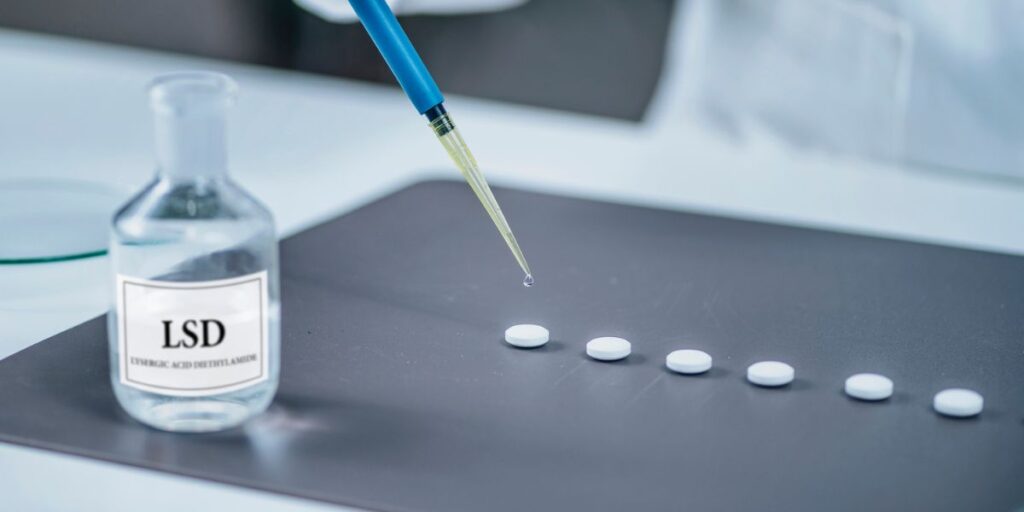LSD (Acid): Types, Effects, and Abuse


LSD, also known as acid, can greatly affect how people see and feel things, taking them on intense journeys called “trips.” These experiences are highly dependent and influenced significantly by the user’s mindset and environment.
This article explores LSD, the different types, and the different ways it can affect people. We look at dangers like falls, mental health problems, abuse, and overdose that can happen with drug use.
We also discuss the lack of proven medical benefits and the risk of becoming mentally dependent on the substance. White Oak Recovery Center helps people recover from LSD abuse with personalized treatment programs to improve mental health.
What Is LSD (Lysergic Acid Diethylamide)?
LSD or lysergic Acid Diethylamide, typically known as acid, is a potent hallucinogen that dramatically changes one’s sensory experiences and consciousness. The ingestion of this substance leads to what is commonly called an ‘acid trip,’ during which the person may undergo a range of intense emotions and thoughts, from overwhelming joy to deep fear.
The NIDA, or the National Institute on Drug Abuse, states that lysergic acid diethylamide stands as the most impactful drug for altering moods and mental states. Enthusiasts of LSD pursue the drug for its hallucinogenic capabilities, often described as ‘trips’ or ‘acid trips.’ Yet, the effects of such experiences can significantly vary, being unpredictable and primarily influenced by the person’s condition and surroundings.
Acid became a pivotal drug of abuse, sparking the ‘psychedelic movement’ in the 1960s. After this era, SAMHSA, the Substance Abuse and Mental Health Services Administration, and NSDUH, the National Survey on Drug Use and Health, constantly report acid, a significant substance of abuse, in their annual surveys.
LSD is manufactured synthetically in laboratories using lysergic acid derived from a fungus called Claviceps purpurea, which grows on rye and other grains. Despite multiple production techniques, all require substantial expertise, knowledge, and a considerable duration to execute. Consequently, most of the acid available in the United States is produced by a select group of chemists. However, small quantities of the substance are also synthesized by independent drug dealers distributed throughout the country.
LSD Drug Types
- Blotter and Blotter acid refers to paper sheets infused with acid that are perforated into small squares.
- Stamps are another term for these perforated paper squares, sometimes adorned with images or designs.
- Sugar cubes can be soaked with acid, serving as an alternative medium for ingestion.
- Blue Heaven and Yellow Sunshine are colloquial names for LSD variants, often indicating the presence of a dye or the perception of the trip’s quality.
- Lucy, or “Lucy in the sky with diamonds,” is a slang reference to LSD, popularized by the Beatles’ song, which is often associated with the drug.
- Windowpane denotes a form of acid that is distributed in thin gelatin squares.
- Trips indicate the experience one undergoes while under the influence of LSD.
- Tabs are small squares cut from blotter paper containing a dose of liquid acid.
- Rainbows and Sunshine Tabs are likely street names for types of LSD, possibly hinting at the user’s visual experience during the trip.
- Microdots are tiny pills or tablets containing LSD.

Effects of LSD
Studies on LSD have found that it affects serotonin receptors in the brain, specifically in the cerebral cortex and locus ceruleus. These areas are important for mood, perception, and processing of sensory signals from the body.
When someone takes LSD, they may experience changes in perception. This drug is also known as ‘tripping on acid.’ These changes can include seeing or hearing things that are not real. These changes can affect how they see the world around them and how they interpret sounds.
It is important to be aware of these potential effects before using LSD. A notable risk of using acid is the profound unpredictability of these effects, such as a ‘bad trip.’
LSD Side Effects
People who use LSD may encounter several negative physical side effects, such as:
- Higher blood pressure
- A rise in body temperature
- Faster heart rate
- Psychological issues, including anxiety and depression
- Feelings of lightheadedness or dizziness
- Sensations of nausea
- A decrease in hunger
- Shaking or trembling
- A sensation of numbness
- Dryness in the mouth
How Long Does an Acid Trip Last?
When consumed by mouth, the impact of an LSD trip typically begins within 30 minutes but can take up to 90 minutes after intake. Interestingly, even a small amount of LSD can trigger effects that can last for as long as 12 hours.
Long-Term Effects of Acid
Two significant long-term negative consequences of using acid include persistent psychosis and hallucinogen-persisting perception disorder (HPPD), often known as ‘flashbacks.’
Persistent Psychosis – A condition involving various mental health challenges that may arise from consuming large quantities of acid. Many users claim that taking drugs can drastically change their outlook on life and how they perceive the world.
However, they might struggle to readjust to everyday life once the drug’s effects fade away. However, they may struggle to adjust to reality once the effects wear off. The psychological issues include:
- Visual distortions
- Disorganized thought processes
- Paranoia
- Alterations in mood
Hallucinogen Persisting Perception Disorder (HPPD)
HPPD is a condition where symptoms are caused by a past hallucinogenic experience, often from using LSD. Symptoms, such as hallucinations or sensory disruptions called flashbacks, can reoccur spontaneously. These symptoms may resurface days or even more than a year after using the drug.

How Much LSD is Lethal?
At high doses of LSD, it can cause extremely distressing symptoms, although these may not always pose a direct threat to life. The significant alteration in perception and mood because of these drugs puts users at a high risk of injury.
People on LSD may do things they wouldn’t usually do, like jumping from moving cars or tall buildings. They could experience intense suicidal thoughts or fail to grasp the seriousness of their actions. Still, as with any drug, there’s the danger of accidental poisoning from contaminated substances or the hazards associated with using multiple drugs simultaneously.
LSD Drug Abuse Treatment
Acid, also known as LSD, doesn’t cause typical withdrawal symptoms or physical addiction. However, it can create a strong psychological dependence as users seek to recreate a positive LSD experience. Some people worry about how acid consumption can impact mental health. This includes causing more antisocial behavior, creating false memories, and leading to holding onto wrong beliefs.
Acid is frequently used with other illegal drugs. It does not provide any therapeutic benefits. It can also lead to mental health issues.
Assistance is readily available; acknowledging the problem is the first step toward recovery. At White Oak Recovery Center, we know how LSD can affect mental health. We provide specific treatments, like medication, to help with symptoms like anxiety, depression, and schizophrenia.
Our facility provides a program to help with mental health conditions. The program includes evidence-based treatments such as medical detox, medication-assisted treatment (MAT), and various comprehensive therapies.
The team at WORC dedicates themselves to helping you live a fulfilling life free from addiction. This team includes a collaborative effort of doctors, nurses, and counselors. They are committed to supporting you on your journey to recovery. Their goal is to provide you with the tools and resources you need to overcome addiction and thrive life-long.
Reach out to speak with one of our caring treatment specialists, eager to help you get on the path to recovery.

Am I covered for addiction treatment?
Your insurance may cover treatment. Call now for an entirely free and confidential assessment. Recovery starts with a phone call.

- Passie, Torsten et al., “The Pharmacology of Lysergic Acid Diethylamide: A Review.” CNS Neuroscience and Therapeutics, 2008.
- “Substance Use – LSD.” MedlinePlus: National Library of Medicine, Apr. 2022.
- Hwang, Kristine Anne J., and Saadabadi, Abdolreza, “Lysergic Acid Diethylamide (LSD).” StatPearls: National Library of Medicine, Jul. 2023
- “Protein Structure Reveals how LSD Affects the Brain.” National Institute of Health, Feb. 2017.
- Das, Saibal, et al., “Lysergic Acid Diethylamide: A Drug of ‘Use’?” Therapeutic Advances in Psychopharmacology, Jun.2016.
Medical Disclaimer:







